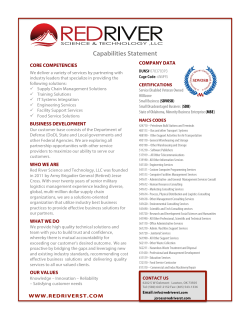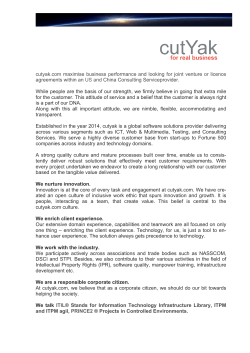
The Competency-based Approach
H A R M S Aviation Training Consulting The Competency-based Approach A Quantum Leap in Pilot Training and Assessment What, Why and How WATS 2015 D. Harms H A R M S Aviation Training Consulting What is competency-based training? Competency-based training is… Training and assessment that is characterized by developing and assessing the overall capability of a trainee across a range of Core Competencies against a predefined norm rather than by measuring the performance of individual tasks or manoeuvres In other words: In competency-based training a task is considered as completed when the Core Competencies have been applied in the correct sequence and weighting H A R M S Aviation Training Consulting The competency based training principle… …is based on the insight that inventory based training and the repetition of past accident scenarios is insufficient to prepare pilots and crews to successfully handle the infinite number of unforeseeable situations and that only the existence and the continuous application of a set of Core Competencies enable pilots and crews to operate safely, efficiently and effectively and manage the threats of modern civil aviation Competency-based training focuses on the training outcome rather than training time. Training hours are replaced by defined performance criteria translated into measurable behavioral indicators. H A R M S Aviation Training Consulting What is competency-based training? It is the shift from merely developing skills by repeating training tasks until the outcome corresponds to the prescribed licensing standard assured by a check ride to the development and continuous application of the Core Competencies enabling a crew to handle an infinite number of abnormal scenarios including the unforeseen In other words: The training task is the „vehicle“ to develop the pilot Core Competencies and their resilient application day by day Mastering the Core Competencies will allow a pilot to manage the infinite number of threats and errors in flight including the previously unseen. and this is the quantum leap H A R M S Aviation Training Consulting Why is it needed? •Task-based (or inventory- based or hours-based) training has reached its limits •In our complex world of aviation it is simply impossible to train the infinite number of all possible abnormal and emergency situations as a means to prepare for the unforeseen. • Meeting the qualification requirements of a license, rating or privilege in terms of hours is not enough The Solution From task-based training to competency-based training S H A R M S Aviation Training Consulting The List of the Core Competencies (Hand out) • Application of Procedures, AOP • Communication, COM • Aircraft Flightpath Managmt-Automation, AFM-Auto • Aircraft Flightpath Managmt-Manual; AFM-Man • Leadership and Teamwork, LTW • Problem Solving and Decision Making, PSD • Situation Awareness, SAW • Workload Management; WLM H A R M S Aviation Training Consulting The Core Competencies … • are applicable to single pilot and multi-crew operations for Captains and Co-pilots • serve as selection criteria during pilot aptitude testing and selection • are the core competencies to be developed during ab-initio training; • are the measurement criteria during type rating, initial line training and recurrent training during the entire career • finally, the core competencies serve as measurement criteria for instructor and evaluator selection and qualification This is called The Total Systems Approach H A R M S Aviation Training Consulting How does competency-based training (and assessment) work? • The behavioral indicators of each of the core competency categories express the knowledge, skills and attitude (KSAs) associated with such competency and serve as measurable performance to be compared with a NORM. In every single training event or training lesson • The competency-based grading system continuously measures the performance level to which the KSAs are being applied to execute the task to the required standard under the given condition. Thus it measures the level of competency achieved. • The system may describe numerical values with precise wordpictures / expressions (descriptors). S H A R M S Aviation Training Consulting The Input-Output Model H A R M S Aviation Training Consulting Competency Based Assessment MATRIX (Model) OUTPUT INPUT (TEM) COM SAW LTW WLM PSD KNO AOP AFMA AFMM NORM NORM NORM NORM Gnd.Ops. Take Off Climb Observed performance compared with norm Cruise Descent Approach Landing NORM NORM NORM NORM NORM H A R M S Aviation Training Consulting Learner centered 5-grade performance level system, an example • Master (5) • Consolidate (4) • Practice (3) • Apply (2) • Describe (1) Each level defined by an observable student behavior, task completion and the magnitude/level of instructor input H A R M S Aviation Training Consulting Competency-based performance level discriptors (model) H A R M S Aviation Training Consulting The interrelation between the Core Competencies, TEM and Airmanship In the context of TEM the 8 Core Competencies (CC) and their respective behavioural indicators constitute the team- and individual countermeasures which the crew applies during all phases of flight to recognize and manage threats, errors and undesired aircraft states to assure a safe flight under all circumstances.. …the Core Competencies describe in detail what is meant by the term Airmanship. Both describe pilot performance H A R M S Aviation Training Consulting The fallacy • If you agree to what I have said isn‘t it obvious that it is the existence and continuous application of the core competencies acquired through a structured training course with continuous performance tracking which makes a good pilot and that experience measured in flying hours is of secondary importance; • And that the assumption that ‘experience as a pilot equates with good performance’ is a dangerous fallacy. • Even if you do not agree to my conclusion it is fact that the days when we could choose our future cockpit crews from applicants which passed the „natural“ selection by having survived thousands of hours „as a pilot“ are irretrievably over. • If you like it or not, we need the new approach! H A R M S Aviation Training Consulting A globally harmonized competency-based training and assessment system can you imagine what it would mean if we could globally agree on a common set of pilot core competencies for civil aviation training, assessment and day by day air carrier operation! • In terms of improving operational safety • In terms of comparability of data • In terms of the simplification of oversight • In terms of harmonizing licensing processes • In terms of permeability of the labor market for pilots • and last not least in terms of costs H A R M S Aviation Training Consulting Let me repeat – The paradigm shift • From hours based to competency based training • The 8 Core Competencies and their behaviour markers are the predominant measurement criteria (beyond fulfilling task completion standards) • From task drill to competency application to prepare for the unforeseen • Training tasks are the vehicle for competency development • Application of TEM as an overarching safety management tool • Data driven through continuous assessment • From tactical to strategicaly thinking • From re-active to pro-active training H A R M S Aviation Training Consulting Competency-based training and assessment is NOT a sophisticated theoretical model It is a solid and practical data driven training method to prepare pilots to successfully handle the challenges of modern civil aviation but it needs • Knowledgable course designers • Well prepared instructors • Well prepared regulators for an effective oversight H A R M S Aviation Training Consulting No presentation without an update on the global status of MPL-because MPL training follows the competency-based training principle Global Status 1. April 2015: 27 programs > 3.100 students enrolled > 1.100 graduates new entrants: ANA, JAL and Etihad Announcements: 1. Co-branded Edition 2 of the IATA Guidance Material and Best Practice for MPL Implementation ready for download from the IATA website soon 2. Global MPL Survey by Rickard Wikander and Nicklas Dahlström from Lund University School of Aviation to receive qualitative data useful to further improving MPL training to start soon Thank You
© Copyright 2025








